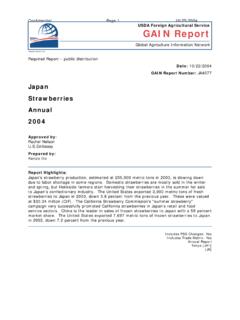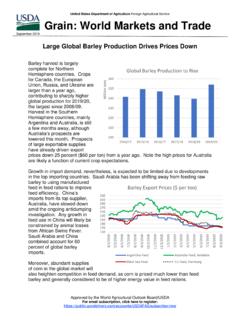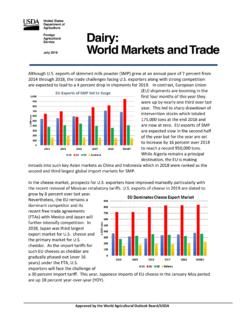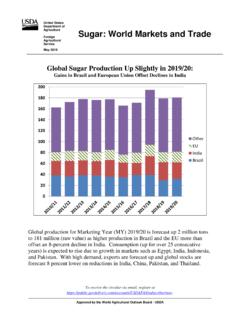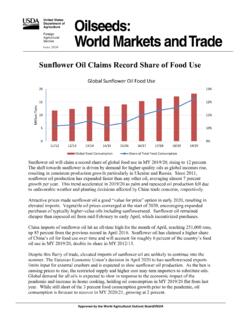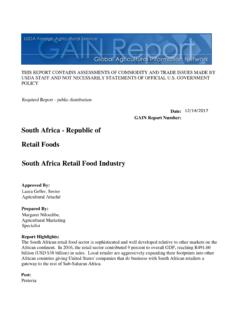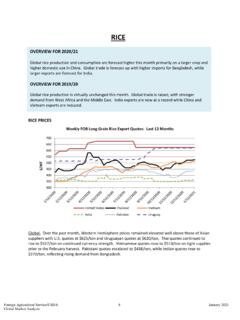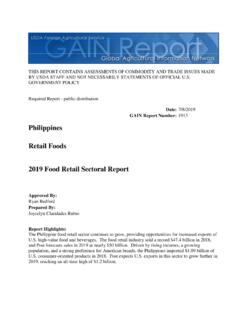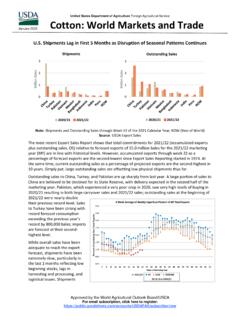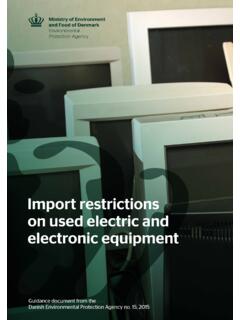Transcription of United States Department of Agriculture Foreign ...
1 United States Department of Agriculture Foreign Agricultural Service Coffee: World Markets and Trade Approved by the World Agricultural Outlook Board/USDA For email subscription, click here to register: December 2021 Brazil: Frosts Heighten Supply Concerns During the final stages of the 2021/22 harvest, there were three instances of severe frost (June 30, July 20, and July 30) that affected some Arabica growing areas in Minas Gerais, Sao Paulo, and Parana. Preliminary estimates indicate between 8 and 10 percent of the Arabica coffee area was affected by the frosts. However, the damage affected mostly leaves and branches, not the beans. Also, most of the harvest had been completed before the arrival of freezing temperatures. Therefore, Brazil s 2021/22 output is unchanged from the initial June 2021 forecast and is still expected to drop million bags from last year s record crop to million.
2 Arabica production remains forecast at million bags, down million from the previous harvest due to a combination of factors. The majority of producing areas were in the off year of the biennial production cycle, resulting in lower output. Persistent drought and high temperatures in major growing regions in the last half of 2020 as well as the beginning of 2021 adversely affected blossoming and fruit development, lowering yields further. There were also reports that many growers pruned their trees at above average rates in response to last year s record on year crop. Robusta production is unchanged from the initial forecast and is expected to reach a record million bags, up million from the previous year. Good rainfall volumes aided fruit development in the major producing States of Espirito Santo, Rondonia, and Bahia.
3 Green coffee exports for 2021/22 are revised million bags lower than the initial forecast due to logistical obstacles. Exporters have struggled to get container and vessel bookings and have experienced frequent postponements and cancellations from shipping companies. Year over year, exports are now expected to plummet million bags to million primarily due to reduced exportable supplies. The next Coffee: World Markets and Trade report is scheduled for publication June 23, 2022 and will include the 2022/23 forecast. Using previous harvests as a guide , Brazil s 2022/23 Arabica production is expected to be an on year of the biennial production cycle. However, output potential has been undermined by the condition of the trees, which have suffered from severe frosts, drought, and high temperatures, as previously noted. Coupled with supply chain disruptions, these concerns have helped push the November 2021 International Coffee Organization (ICO) monthly composite price index up 70 percent in the last year to $ Brazil s Off Year Arabica Production DropsBelow Trend as Robusta Reaches Record0510152025303540455055 2015/16 2016/17 2017/18 2018/19 2019/20 2020/21 2021/22 Million 60 Kilogram Bags Arabica RobustaOff YearOff YearOff YearOff Year 2021/22 Coffee Overview World coffee production for 2021/22 is forecast down million bags from the previous year to million, due primarily to Brazil s combined effect of Arabica trees entering the off year of the biennial production cycle and a weather related shortfall.
4 As a result of lower output, global ending inventories are expected to drop million bags to million. World coffee bean exports are expected down million bags to million as lower exports from Brazil more than offset higher shipments from Vietnam. Global consumption rises million bags to million, with the largest gains in the European Union, the United States , and Brazil. Brazil production is forecast down million bags to million compared to the previous year. Arabica output is forecast to drop million bags to million due to lower yields from the off year, drought, and high temperatures. The Robusta harvest is forecast to continue expanding to reach a record million bags, up million. Despite lower output, consumption is expected to continue rising to a record million bags. With reduced supplies, bean exports are expected to plunge million bags from last year s record to million bags and ending stocks are forecast to decline 500,000 bags to million.
5 Vietnam production is forecast to rebound million bags to million following last year s dry growing conditions. With Robusta accounting for over 95 percent of total output and Robusta prices trending higher over the last 12 months, many growers were motivated to boost yields by incurring irrigation costs during the normally drier period of January through March. Farmers continue to intercrop coffee with fruits, such as avocado and durian, to boost their incomes. Bean exports are forecast to jump million bags to million, lowering inventories slightly. Colombia Arabica production is forecast 400,000 bags higher to million on favorable growing conditions. The National Federation of Coffee Growers of Colombia (FEDECAFE) estimates that nearly 85 percent of coffee area is now planted with rust resistant varieties, compared to just 35 percent in 2008/09 when adverse weather conditions caused rust to proliferate, lowering output by one third.
6 Since then, yields have increased about 30 percent due largely to the renovation program that replaced older, lower yielding trees with rust resistant varieties. The program also reduced the average age of coffee trees from 15 to 7 years, further boosting yields. Bean exports are expected to rise million bags to million as inventories are drawn lower. Indonesia production is forecast to slip a modest 100,000 bags to million, with most of the loss occurring in Robusta output. Robusta production is expected at nearly million bags on mostly favorable growing conditions in the lowland areas of Southern Sumatra and Java, where approximately 75 percent of the crop is grown. Heavy rains in northern Sumatra, where approximately 60 percent of 140 145 150 155 160 165 170 175 1802016/172017/182018/192019/202020/2120 21/22 Million 60 Kilogram BagsProductionConsumptionRising World Consumption With Reduced 60 Kilogram BagsEnding World Ending StocksForeign Agricultural Service/USDA 2 December 2021 Global Market Analysis Arabica output is derived, are expected to have lowered yields, with output down slightly to almost million bags.
7 Ending stocks are expected to halve to just 800,000 bags, to sustain rising consumption and strong exports. India production is forecast to add 300,000 bags to million on higher Robusta output in Karnataka, the largest coffee producing state. Arabica is forecast modestly lower as it enters the off year of the biennial production cycle. Bean exports are forecast up 100,000 bags to million. Total output for Central America and Mexico is forecast up 700,000 bags to million on gains in Honduras, Guatemala, Nicaragua, and Mexico. Bean exports for the region are forecast to gain 700,000 bags to million due to higher exportable supplies. Nearly half of the region s exports are destined for the European Union, followed by about one third to the United States . European Union imports are forecast down million bags to million and account for nearly 40 percent of the world s coffee bean imports.
8 Top suppliers include Brazil (34 percent), Vietnam (24 percent), Honduras (8 percent), and Colombia (6 percent). Ending stocks are expected to drop million bags to million to support a modest increase in consumption. The United States imports the second largest amount of coffee beans and is forecast up 700,000 bags to million. Top suppliers include Brazil (30 percent), Colombia (21 percent), Vietnam (11 percent), and Nicaragua (5 percent). Ending stocks are forecast to slide 200,000 bags to million. Revised 2020/21 World production is revised up 100,000 bags from the June 2021 estimate to million. Colombia is lowered 900,000 bags to million due to lower yields from adverse weather conditions. Guatemala is raised 500,000 bags to million due to higher yields. World bean exports are raised 700,000 bags to million.
9 Colombia is lowered million bags to million on lower exportable supplies. Brazil is revised 700,000 bags higher to million on higher than anticipated stocks drawdown. World ending stocks are lowered million bags to million. European Union is revised million bags lower to million on updated data from the European Coffee Federation. Brazil is lowered 600,000 bags to million on higher shipments. Output Rebounding in Central America and Mexico 3 6 9 12 15 18 212016/172017/182018/192019/202020/21202 1/22 Million 60 Kilogram BagsOthersNicaraguaGuatemalaHondurasOthe rs includes Costa Rica, El Salvador, Mexico, and PanamaForeign Agricultural Service/USDA 3 December 2021 Global Market Analysis The next release of this publication will be on June 23, 2022.
10 For additional information, please contact Tony Halstead (202 720 4620, or Charles Shell The Coffee: World Markets and Trade circular is based on reports from FAS Overseas Posts since November 2021 and on available secondary information. The individual country reports can be obtained on FAS Online at: European Union definition: includes 27 countries in the customs union (Austria, Belgium/Luxembourg, Bulgaria, Croatia, Cyprus, Czech Republic, Denmark, Estonia, Finland, France, Germany, Greece, Hungary, Ireland, Italy, Latvia, Lithuania, Malta, Netherlands, Poland, Portugal, Romania, Slovakia, Slovenia, Spain, and Sweden). Effective January 1, 2021, the separation of the United Kingdom (UK) from the European Union (EU) was complete, including trade between both entities. Starting in June 2021 with the release of 2021/22 data, coffee PSDs reflect EU27 (shown in the PSD system as European Union ) and UK separately.)

